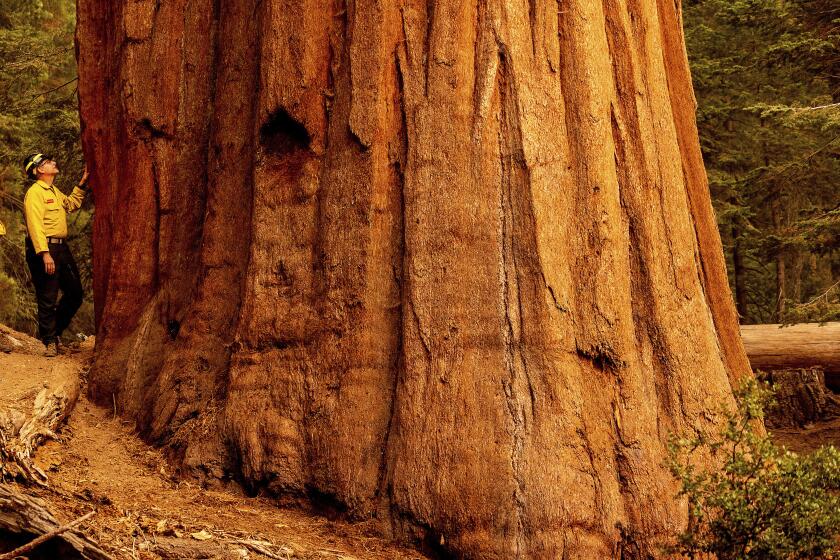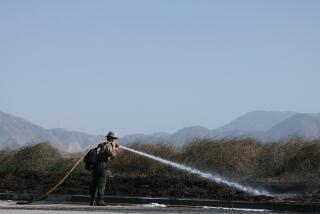Crews scramble to make progress against California wildfires

Crews were hoping a shift in the weather would help them get the upper hand against several wildfires burning in Northern California and the southern Sierra. But forecasters warned Saturday the window of opportunity could be short-lived, as a cooling trend was expected to be followed by warmer temperatures and dry winds.
The Fawn fire north of Redding had burned 7,544 acres and was 10% contained as of Saturday morning. At least 100 structures were believed to have been destroyed based on a survey by fire crews, but damage assessment teams were out Saturday conducting a more detailed review, said Scott Ross, public information officer with the California Department of Forestry and Fire Protection.
The fire started Wednesday and quickly spread amid gusty winds, forcing evacuations, Ross said.
Alexandra Souverneva, 30, of Palo Alto, was charged with arson for allegedly sparking the fire. Authorities did not disclose a potential motive but said she may be linked to other fires in the county and state.
The fire was burning in steep terrain through heavy brush, oak and pine, Ross said. Some evacuations were lifted Saturday as its growth slowed.
Conditions had already started to cool off, helping to boost relative humidity levels. The trend was expected to continue, with temperatures at least 10 degrees below average by Tuesday, said Sierra Littlefield, a meteorologist with the National Weather Service in Sacramento.
A storm system moving into the Pacific Northwest on Monday night into Tuesday could also bring a small amount of precipitation to the area, potentially less than a tenth of an inch, Littlefield said.
“Most of the brunt will be well to our north,” she said. “We’ll be getting the tail end in Northern California.”
But as the system moves out mid to late week, it’s possible that drier, breezier conditions will develop behind it, Littlefield said.
“We’ll also see temperatures trending up toward next weekend as high pressure builds in behind that passage of the low-pressure system,” she said.
Increasing evaporative demand is escalating summertime drought severity in California and the West, according to climate researchers.
Firefighters were scrambling to contain the Fawn fire ahead of the potential wind event, Ross said.
“We’re going to try and get this wrapped up before then so that doesn’t impact us,” he said.
The fire was one of 11 active wildfires burning in California that had drawn more than 9,800 personnel, according to Cal Fire. So far this year, 7,641 fires have scorched more than 2.4 million acres in the state, outpacing every other year except last year, when nearly 3.7 million acres had burned by this date.
Authorities say these fires are also becoming more intense and harder to fight. Experts attribute the shift to drought and heat waves exacerbated by climate change, as well as overgrown forests that are helping to fuel high-severity fires with buildups of dry, dead vegetation.
Nearly 350 miles southeast of the Fawn fire, the 42,048-acre KNP Complex fire continued to grow in Sequoia and Kings Canyon National Park. Authorities reported 0% containment as of Saturday morning.
Friday was one of the most active days for the fire since it was sparked by a Sept. 9 lightning storm, said Mark Garrett, public information officer with the National Park Service.
That’s in part because it moved down into the foothills closer to the visitors center, picking up speed as it moved from mixed-conifer forests to grass and oak woodlands, Garrett said. Crews were able to meet the fire there using backfiring operations, as well as helicopters that were able to get up earlier in the day and assist before the smoke set in, he said.
Along the southern tip of the fire, flames slopped over control lines along Paradise Ridge and were continuing to move uphill on the slope, which is overgrown and has no recent history of fire, Garrett said.
A finger of the fire was coming down to Mineral King Road, a couple miles west of cabin communities in the area, and crews were trying to stop it from moving closer to homes, he said.
“We pulled some resources from other divisions and are getting eyes on that down there and seeing where we’re able to hold it or not,” Garrett said, adding that crews are hoping to take advantage of the fact that the fire is moving downhill, rather than racing uphill, in that area.
“It is also encountering lighter fuels like grasses, which makes it much easier to contain down there,” he said.
Crews have used controlled burns, protective foil and other protective measures to guard Sequoia National Park.
Fire crews have largely been able to save the Giant Forest, the park’s largest concentration of giant sequoias that is home to the famed General Sherman tree, believed to be the world’s largest by volume. The fire did burn sequoias on the perimeter of the forest when it scorched the western edges, Garrett said,
“Some bigger trees have big holes or caves under them so the fire gets under there and cooks and cooks,” he said.
A giant sequoia believed to have been killed by the fire fell across Generals Highway right before the Four Guardsmen trees on Friday, for a time blocking crews from being able to travel from the northern portion of the fire to the southern portion, he said.
A hotshot crew was able to cut out a large section of the tree and a road grader pushed the material away so that people could drive through it, he said.
“If you drive up there on either side of the road, there’s just a huge sequoia cutout that’s even taller than me,” he said. “That’s going to be there forever now.”
A high-pressure system was helping to hold thick smoke over the area, which was suppressing fire behavior by keeping temperatures lower and humidity levels higher, but also preventing aircraft from flying, Garrett said.
“So it’s a double-edged sword, as they say,” he said. “Either way, we’re going to use what we can to our advantage.”
In some areas, crews were spraying retardant from trucks near fire lines to help create buffers, similar to how aircraft would do it but slower, Jon Wallace, operations sections chief, said in a morning briefing.
The fire’s rapid growth was being fed by beetle-killed trees, Garrett said, estimating there are more than a million of them in Sequoia and Kings Canyon National Park alone.
“That is helping fuel this fire with a lot of extra dead and dry vegetation that is available and ready to burn,” Garrett said. “It also creates a lot of fire-weakened trees falling all over the highway and endangering people’s lives.”
Similar dynamics were in place around the nearby Windy fire burning in the Tule River Reservation and Sequoia National Forest, which had destroyed two commercial structures and forced 430 people from their homes.
The fire was also sparked by lightning Sept. 9. It had grown to 71,349 acres and was 5% contained as of Saturday morning.
Specialists have been checking on giant sequoia groves, including the Long Meadow Grove where the Trail of 100 Giants is located, with drones flying over other areas that are hard to reach, to see how intensely the fire burned through. So far, most of the trees appear to have escaped major damage, said Nathan Judy, public information officer for California Incident Management Team 5.
The fire has been growing in all directions, with winds pushing embers and firebrands in front of the main firefront during windy conditions Thursday night, he said. Some of those turned into spot fires that made runs on Friday, when the heat of the day kicked up and humidity dropped, he said.
The fire was not that active overnight into Saturday, as relative humidity recoveries improved, Judy said. Still, the activity was expected to pick up as the day progressed, and crews were toiling to catch spot fires in steep, inaccessible terrain, he said.
Weather trends were similar to those over the Fawn fire, with temperatures expected to drop a couple degrees each day through Tuesday, when they were forecast to be about 10 degrees below average, said Brian Ochs, meteorologist with the National Weather Service in Hanford.
Temperatures are expected to then increase to near average or slightly warmer than average by Thursday or Friday, he said.
Wind gusts could also increase Tuesday as the cold front moves in with the storm system to the north, which is not expected to drop precipitation as far south as the Windy or KNP Complex fires, Ochs said.
The fires were compromising air quality and resulting in smoky skies throughout Central California and as far south as Los Angeles.
More to Read
Start your day right
Sign up for Essential California for news, features and recommendations from the L.A. Times and beyond in your inbox six days a week.
You may occasionally receive promotional content from the Los Angeles Times.









